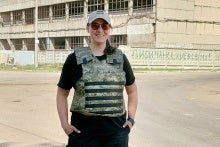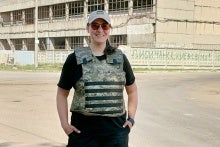Women have been on the front lines of Russia’s war on Ukraine. Their suffering has been disproportionate and relentless, with women and children making up almost 90 per cent of people fleeing the war. But that is not the whole picture. Women are also humanitarian actors, community leaders, and providers for their families. One in every two businesses in Ukraine is founded by a woman. Ukrainian women are also taking on more roles in traditionally male-dominated professions, such as the security sector, transit, and demining.
Since Russia’s large-scale invasion of Ukraine in 2022, women’s rights organizations and women leaders have been providing humanitarian assistance, advocating for women’s rights, taking on leadership roles in business and in politics, and many have joined the armed forces.
Read the stories of Ukrainian women on the front lines of the war and recovery efforts.
Kseniia Mishyna: The acting village head
Kseniia Mishyna cannot remember when she last ate or slept in calm, had time for relatives, or herself. She heads four villages in the Dniprovks district in Bilozershchina, Ukraine, all severely impacted by the war. She leads and coordinates safe evacuation of residents, sources essential items, such as fire extinguishers and generators, and oversees the maintenance of electricity and gas networks.
Mishyna is known for her driving skills, navigating hard to reach places on the front lines of the war, to deliver food. In areas where basic infrastructure has collapsed, Mishyna delivers essential humanitarian aid.
“I can’t imagine myself anywhere else,” says Mishyna, even when she is exhausted. “Managing a team, negotiating, finding money, suppliers, logistics… And suddenly, realizing I did not have a single day of rest.”
Even the resilient need rest, replenishment, and support. Mishyna could access psychological support and learn self-care at a local NGO through a programme supported by UN Women and funded by the United Nations Women’s Peace and Humanitarian Fund (WPHF). Today, she is an active participant in the women’s group, where they create a safe space for one another to share experiences, seek help, and rest.
“You have two hands, one to help yourself, and the second to help others,” says Mishyna. “Only stable and healthy people don’t give up, dream, and help others.”
Community leaders and women’s organizations in Ukraine need urgent and continued support. Over half of the 14.6 million people in need of humanitarian assistance in Ukraine are women and girls. In 2023, the Women, Peace, and Humanitarian Fund, managed by UN Women, distributed USD 10 million to women-led organizations providing humanitarian response in Ukraine, and to support community-led recovery efforts. UN Women is also supporting initiatives to boost women’s livelihoods and participation in decision-making and governance.
Hanna Demydenko: Advocating for rights and social protection for military volunteers
Hanna Demydenko was planning to pursue a career in online marketing, but she became a volunteer military paramedic when Russia launched military aggression against Ukraine in 2014. Her husband joined the Donbas Battalion.
One year on, Hanna, together with a colleague, set up an organization to help volunteers and their families, including the families of volunteers who were killed, get social protection guarantees at the state level.
“Almost no one believed we could succeed, but we kept collecting the necessary documents of those killed and wounded,” said Demydenko. “We prepared and handed over a full package of documents to the families and accompanied them throughout the legal proceedings, to get recognition and benefits.”
In 2019, their work paid off. Draft law No. 2045-1 was passed, and it recognizes military volunteers as combatants, so they can access the social protection measures and state support that military veterans and their families receive.
Demydenko is an activist and works with several organizations, including the Ukrainian Women Veterans Movement, ‘Veteranka’, supported by UN Women, and ‘The Legal Hundred’, a local NGO that provides social and legal protection to veterans and their families.
“The Veteranka Movement remains a place of unity and solidarity for me. With support from UN Women, I work with female veterans to advocate for the rights of women in the army,” said Demydenko. “We also support the rehabilitation of female veterans, so they can come back to accessible homes, stable income, quality medical care, and welcoming communities.”
As of January 2024, according to the Ministry of Defense of Ukraine, nearly 67,000 women were in the Ukrainian Armed Forces[1]. Non-profit organizations like the Veteranka Movement have advocated to change laws, making it possible for women to hold combat positions.
Iryna Klochko: Supporting and speaking out for women in the military
Thousands of women joined the Ukrainian armed forces to defend their country when Russia started its military aggression in 2014, followed by the full-scale invasion on 24 February, 2022. Many were trained as the war unfolded and slipped into uniforms that were made for men, like Iryna Klochko. The 38-year-old intelligence analyst with the Ukrainian air intelligence unit used to be a television director in Kyiv.
“I asked a friend to help me find a job in the army,” recalled Klochko. “There were two options: sniper or decipherer [analyst]. I didn’t want to be a sniper. I also didn’t know anything about [deciphering codes] … I learned everything from my comrades.”
For seven years before the war, Klochko had worked in television with men who reported to her. Almost overnight, she found herself in a job where men commanded her.
“Most women who join the army struggle with the uniforms,” shared Klochko. “All military clothes and equipment are made for men. You wouldn’t be able to move quietly, because your trousers are so large, they would rustle.”
Even the bulletproof vests are not made to fit women, she added: “When you wear it all day, it hurts.”
Klochko recently joined the Veteranka Movement. As part of its efforts to advocate for the rights of women in the military, Veteranka runs tailoring workshops to design military uniforms for women, free of charge. The organization is also advocating to introduce standard uniforms for women in military service. The Ministry of Defense has approved a sample for the summer uniform, but standard winter uniforms for women are yet to be introduced.
UN Women works with more than 40 women’s organizations in Ukraine and have supported over 100,000 women and girls through its programmes. Funding women-led and women’s rights organizations in conflict- and war-affected countries is critical for sustainable peace and development. Yet, globally, such funding is less than one per cent of the Official Development Assistance (ODA). According to OECD DAC data, 90 per cent of bilateral ODA to Ukraine in 2022 did not include any gender equality objectives and only 0.2 per cent of funding was for projects with gender equality as the principal objective[2].

